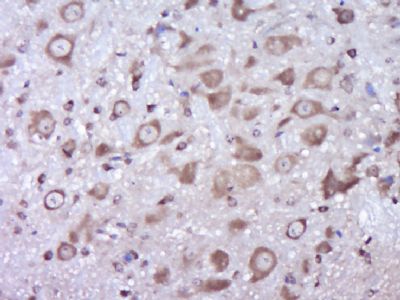Secretory phospholipase A2 Polyclonal Antibody
Purified Rabbit Polyclonal Antibody (Pab)
- 产品详情
- 实验流程
Application
| IHC-P, IHC-F, IF, ICC, E |
|---|---|
| Primary Accession | P31482 |
| Reactivity | Rat |
| Host | Rabbit |
| Clonality | Polyclonal |
| Calculated MW | 16145 Da |
| Physical State | Liquid |
| Immunogen | KLH conjugated synthetic peptide derived from mouse PLA2G2A |
| Epitope Specificity | 23-100/146 |
| Isotype | IgG |
| Purity | affinity purified by Protein A |
| Buffer | Preservative: 0.02% Proclin300, Constituents: 1% BSA, 0.01M PBS, pH7.4. |
| SUBCELLULAR LOCATION | Membrane. |
| SIMILARITY | Belongs to the phospholipase A2 family. |
| Important Note | This product as supplied is intended for research use only, not for use in human, therapeutic or diagnostic applications. |
| Background Descriptions | The protein encoded by this gene is a member of the phospholipase A2 family (PLA2). PLA2s constitute a diverse family of enzymes with respect to sequence, function, localization, and divalent cation requirements. This gene product belongs to group II, which contains secreted form of PLA2, an extracellular enzyme that has a low molecular mass and requires calcium ions for catalysis. It catalyzes the hydrolysis of the sn-2 fatty acid acyl ester bond of phosphoglycerides, releasing free fatty acids and lysophospholipids, and thought to participate in the regulation of the phospholipid metabolism in biomembranes. Several alternatively spliced transcript variants with different 5' UTRs have been found for this gene.[provided by RefSeq, Sep 2009] |
| Gene ID | 18780 |
|---|---|
| Other Names | Phospholipase A2, membrane associated, 3.1.1.4, Enhancing factor, EF, GIIC sPLA2, Group IIA phospholipase A2, Phosphatidylcholine 2-acylhydrolase 2A, Pla2g2a |
| Dilution | IHC-P=1:100-500,IHC-F=1:100-500,ICC=1:100-500,IF=1:100-500,ELISA=1:5000-10000 |
| Format | 0.01M TBS(pH7.4) with 1% BSA, 0.09% (W/V) sodium azide and 50% Glyce |
| Storage | Store at -20 °C for one year. Avoid repeated freeze/thaw cycles. When reconstituted in sterile pH 7.4 0.01M PBS or diluent of antibody the antibody is stable for at least two weeks at 2-4 °C. |
| Name | Pla2g2a |
|---|---|
| Function | Secretory calcium-dependent phospholipase A2 that primarily targets extracellular phospholipids with implications in host antimicrobial defense, inflammatory response and tissue regeneration (PubMed:10358193, PubMed:11694541, PubMed:8425615). Hydrolyzes the ester bond of the fatty acyl group attached at sn-2 position of phospholipids (phospholipase A2 activity) with preference for phosphatidylethanolamines and phosphatidylglycerols over phosphatidylcholines. Contributes to lipid remodeling of cellular membranes and generation of lipid mediators involved in pathogen clearance. Displays bactericidal activity against Gram-positive bacteria by directly hydrolyzing phospholipids of the bacterial membrane (PubMed:11694541). Upon sterile inflammation, targets membrane phospholipids of extracellular mitochondria released from activated platelets, generating free unsaturated fatty acids such as arachidonate that is used by neighboring leukocytes to synthesize inflammatory eicosanoids such as leukotrienes. Simultaneously, by compromising mitochondrial membrane integrity, promotes the release in circulation of potent damage-associated molecular pattern molecules that activate the innate immune response (By similarity). Plays a stem cell regulator role in the intestinal crypt. Within intracellular compartment mediates Paneth cell differentiation and its stem cell supporting functions by inhibiting Wnt signaling pathway in intestinal stem cell (ICS). Secreted in the intestinal lumen upon inflammation, acts in an autocrine way and promotes prostaglandin E2 synthesis that stimulates Wnt signaling pathway in ICS cells and tissue regeneration (PubMed:27292189). May play a role in the biosynthesis of N-acyl ethanolamines that regulate energy metabolism and inflammation. Hydrolyzes N-acyl phosphatidylethanolamines to N-acyl lysophosphatidylethanolamines, which are further cleaved by a lysophospholipase D to release N-acyl ethanolamines (By similarity). Independent of its catalytic activity, acts as a ligand for integrins. Binds to and activates integrins ITGAV:ITGB3, ITGA4:ITGB1 and ITGA5:ITGB1. Binds to a site (site 2) which is distinct from the classical ligand-binding site (site 1) and induces integrin conformational changes and enhanced ligand binding to site 1. Induces cell proliferation in an integrin-dependent manner (By similarity). |
| Cellular Location | Secreted {ECO:0000250|UniProtKB:P14555}. Cell membrane {ECO:0000250|UniProtKB:P14555}; Peripheral membrane protein {ECO:0000250|UniProtKB:P14555}. Mitochondrion outer membrane {ECO:0000250|UniProtKB:P14555}; Peripheral membrane protein {ECO:0000250|UniProtKB:P14555} |
| Tissue Location | Mainly in the Paneth cells adjacent to the stem population in the small intestines. |
Research Areas
For Research Use Only. Not For Use In Diagnostic Procedures.
Application Protocols
Provided below are standard protocols that you may find useful for product applications.
终于等到您。ABCEPTA(百远生物)抗体产品。
点击下方“我要评价 ”按钮提交您的反馈信息,您的反馈和评价是我们最宝贵的财富之一,
我们将在1-3个工作日内处理您的反馈信息。
如有疑问,联系:0512-88856768 tech-china@abcepta.com.























 癌症的基本特征包括细胞增殖、血管生成、迁移、凋亡逃避机制和细胞永生等。找到癌症发生过程中这些通路的关键标记物和对应的抗体用于检测至关重要。
癌症的基本特征包括细胞增殖、血管生成、迁移、凋亡逃避机制和细胞永生等。找到癌症发生过程中这些通路的关键标记物和对应的抗体用于检测至关重要。 为您推荐一个泛素化位点预测神器——泛素化分析工具,可以为您的蛋白的泛素化位点作出预测和评分。
为您推荐一个泛素化位点预测神器——泛素化分析工具,可以为您的蛋白的泛素化位点作出预测和评分。 细胞自噬受体图形绘图工具为你的蛋白的细胞受体结合位点作出预测和评分,识别结合到自噬通路中的蛋白是非常重要的,便于让我们理解自噬在正常生理、病理过程中的作用,如发育、细胞分化、神经退化性疾病、压力条件下、感染和癌症。
细胞自噬受体图形绘图工具为你的蛋白的细胞受体结合位点作出预测和评分,识别结合到自噬通路中的蛋白是非常重要的,便于让我们理解自噬在正常生理、病理过程中的作用,如发育、细胞分化、神经退化性疾病、压力条件下、感染和癌症。






